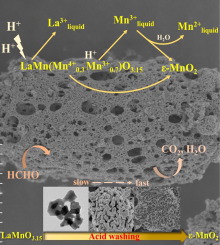Chemical Engineering Journal ( IF 15.1 ) Pub Date : 2020-01-20 , DOI: 10.1016/j.cej.2020.124146 Yin Xu , Jérémy Dhainaut , Guillaume Rochard , Jean-Philippe Dacquin , Anne-Sophie Mamede , Jean-Marc Giraudon , Jean-François Lamonier , Hui Zhang , Sébastien Royer

|
A simple template-free method, based on a mineral acid etching process using manganite perovskite (LaMnO3) as precursor, was successfully developed to obtain a series of 3D meso/macro-porous materials. The LaMnO3 transformation was fully investigated using ICP, XRD, N2 physisorption, TPR, TPD, SEM, TEM/EDS and XPS. This transformation proceeds through a soft-chemical process involving the dissolution of trivalent lanthanum and manganese from the perovskite structure and the dismutation of Mn3+ cations into MnO2 and Mn2+ species. Strength and oxidizing properties of the acid used as modifying agent strongly impact textural and redox surface properties of the resulting materials. Specifically, extending the acid etching duration promotes the surface area and pore volume of the materials while developing interconnected macro-mesoporous networks. In our case, this soft process allowed us to obtain the ε-MnO2 phase with hierarchical porosity without any template. Superior catalytic properties of ε-MnO2 were observed toward HCHO oxidation as well as a good catalytic stability with respect to other macro-mesoporous counterparts. In the light of the experimental results, such performances can be related to the formation of a meso/macro-porous structure conferring high surface area and good accessibility of the active surface sites. The latter exhibit greater redox ability of the manganese species and a higher density of active surface oxygen species with respect to the perovskite precursor.
中文翻译:

分级多孔ε-的MnO 2从钙钛矿前体:应用到甲醛总氧化
成功开发了一种简单的无模板方法,该方法基于无机酸蚀刻工艺,使用锰酸钙钙钛矿(LaMnO 3)作为前体,从而获得了一系列3D介孔/大孔材料。使用ICP,XRD,N 2物理吸附,TPR,TPD,SEM,TEM / EDS和XPS对LaMnO 3的转化进行了充分研究。这种转变是通过软化学过程进行的,该过程包括从钙钛矿结构中溶解三价镧和锰,以及将Mn 3+阳离子歧化为MnO 2和Mn 2+种类。用作改性剂的酸的强度和氧化性能会严重影响所得材料的质构和氧化还原表面性能。特别地,延长酸蚀刻的持续时间可促进材料的表面积和孔体积,同时形成相互连接的宏观中孔网络。在我们的例子中,这种软的过程使我们能够获得ε-的MnO 2相具有分级的多孔没有任何模板。的优异的催化性能ε-的MnO 2观察到对HCHO的氧化以及相对于其他大中观对应物的良好催化稳定性。根据实验结果,这些性能可能与介孔/大孔结构的形成有关,该结构赋予了高表面积和活性表面位点的良好可达性。相对于钙钛矿前体,后者表现出更高的锰物种的氧化还原能力和更高的活性表面氧物种密度。

























 京公网安备 11010802027423号
京公网安备 11010802027423号